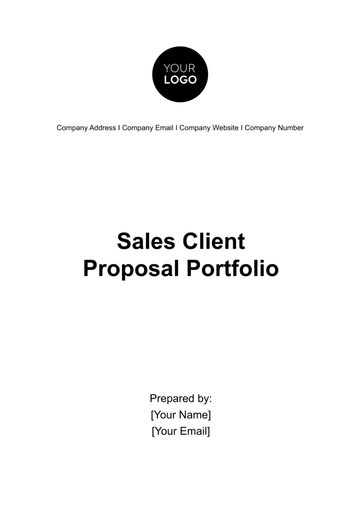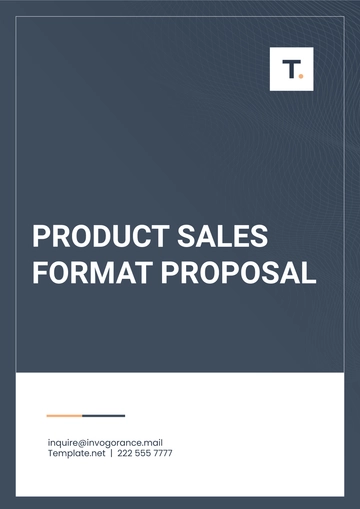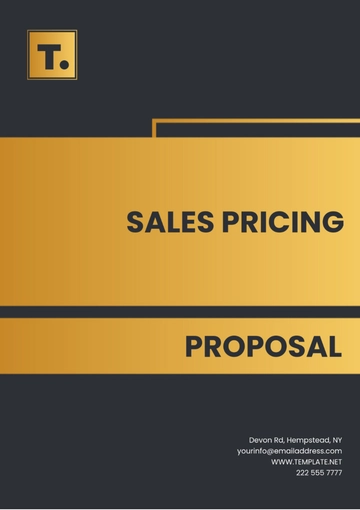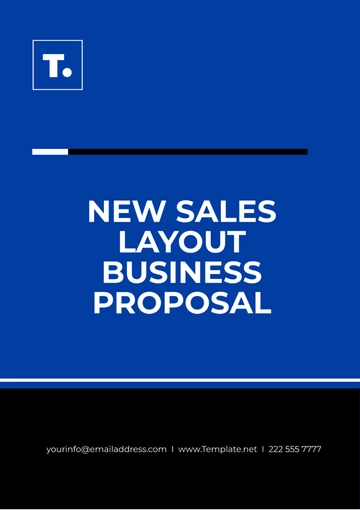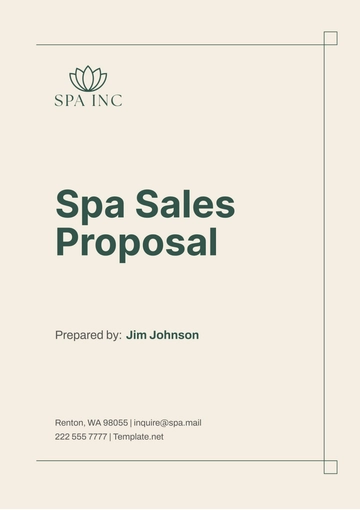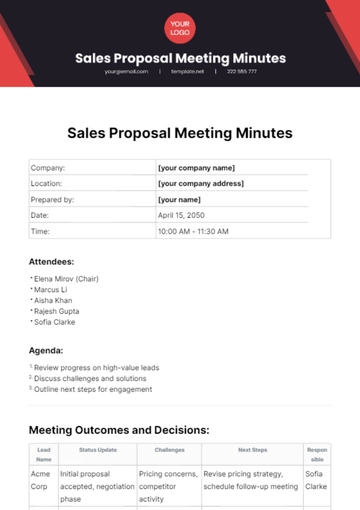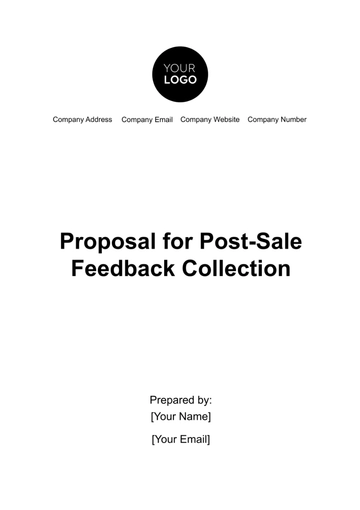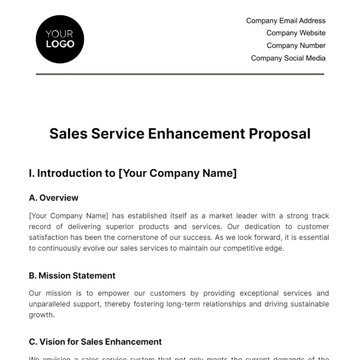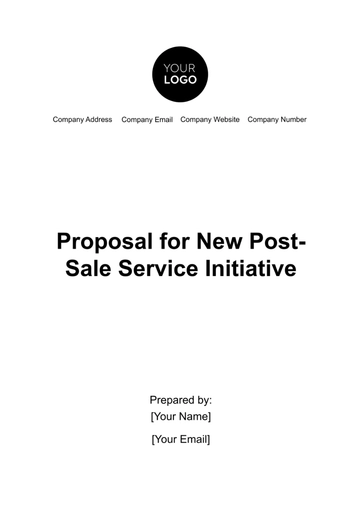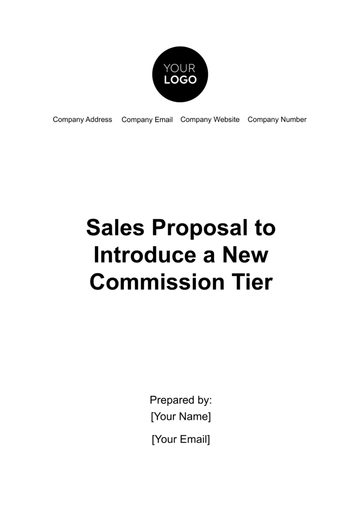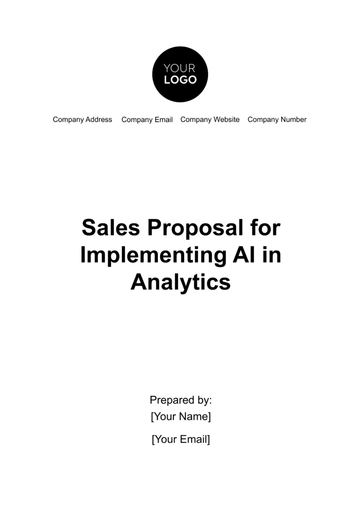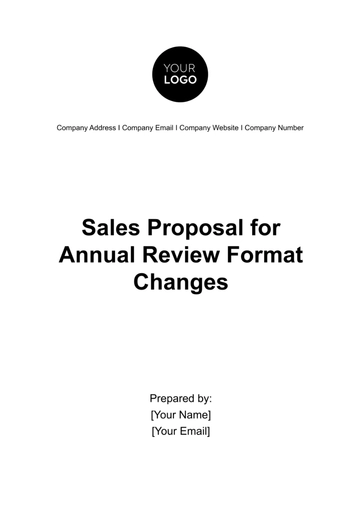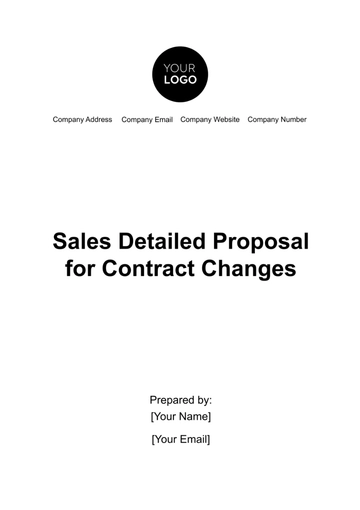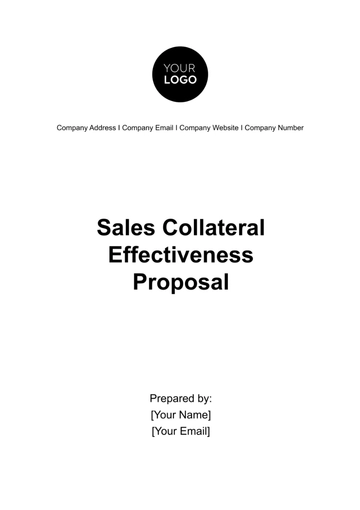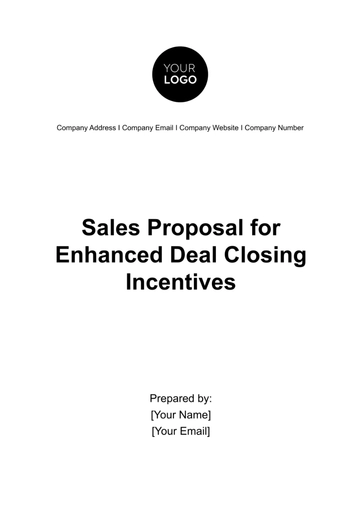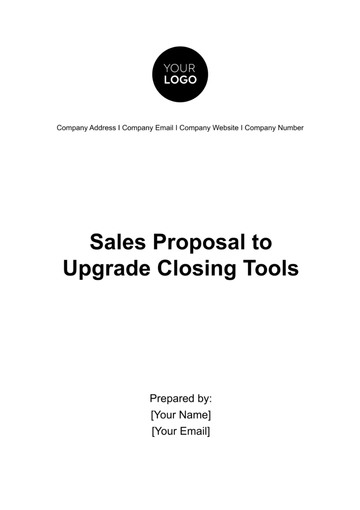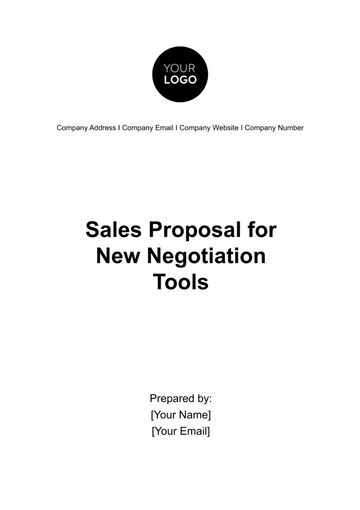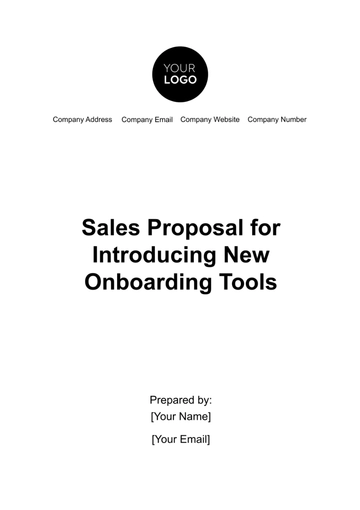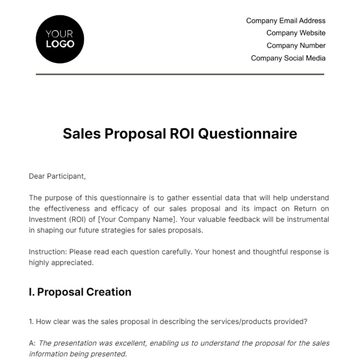Free Sales Proposal Case Study

Prepared by: | Date: |
|---|---|
[Your Name] | [Current Date] |
I. Executive Summary
[Your Company Name], a leading provider of innovative solutions in the [industry] sector, is thrilled to present this Sales Proposal Case Study, showcasing our successful partnership with [Client Company Name]. By leveraging our cutting-edge [Product/Service], we were able to address [Client Company Name]'s unique challenges and deliver outstanding results. This case study demonstrates our unwavering commitment to exceeding client expectations and highlights the tangible benefits of our solutions.
II. Introduction
In today's competitive business landscape, companies across all industries face a myriad of challenges that demand innovative solutions. In this context, [Client Company Name] approached [Your Company Name] seeking assistance in addressing their [specific pain point or challenge]. This section provides an overview of [Client Company Name]'s background, highlighting the challenges they faced and the objectives they aimed to achieve. Additionally, it outlines the structure of this sales proposal case study, offering a roadmap for readers to navigate through our successful collaboration and the transformative results achieved.
III. Client Background
A. Company Profile
Client Company Name: [Client Company Name]
Industry: Technology
Location: [Silicon Valley, California]
Number of Employees: [500]
Annual Revenue: [$50 million]
B. Challenges Faced
[Client Company Name] was confronted with several challenges in their product development process, including:
Inefficient collaboration among cross-functional teams leading to delays in product releases.
Difficulty in tracking project progress and identifying bottlenecks.
Lack of real-time visibility into project statuses, hindering decision-making processes.
These challenges resulted in missed deadlines, increased costs, and decreased customer satisfaction.
IV. Proposal Overview
In response to [Client Company Name] challenges, [Your Company Name] proposed a comprehensive solution aimed at streamlining their product development process and improving overall efficiency. The proposed solution encompasses the following key components:
A. Proposed Solution
[Your Company Name] proposed the implementation of our flagship project management software, [Product Name], tailored to meet [Client Company Name] specific needs. [Product Name] offers advanced features such as task assignment, progress tracking, resource allocation, and real-time reporting, all within a user-friendly interface. By centralizing project management activities and providing visibility into project statuses, [Product Name] enables seamless collaboration and facilitates informed decision-making across teams.
B. Key Features
Task Assignment: Assign tasks to team members, set deadlines, and track progress in real-time. With [Product Name], [Client Company Name] can ensure that each team member knows their responsibilities and deadlines, fostering accountability and transparency.
Progress Tracking: Monitor project milestones, identify bottlenecks, and take proactive measures to ensure timely completion. Through intuitive dashboards and progress tracking tools, [Product Name] empowers [Client Company Name] to stay on top of project timelines and address any issues promptly.
Resource Allocation: Allocate resources efficiently, optimize workforce utilization, and prevent resource conflicts. By providing insights into resource availability and workload distribution, [Product Name] enables [Client Company Name] to allocate resources strategically, maximizing productivity and minimizing project delays.
Real-time Reporting: Generate customizable reports to gain insights into project performance and make data-driven decisions. With [Product Name]'s robust reporting capabilities, [Client Company Name] can access real-time data on project progress, budget utilization, and resource allocation, allowing them to identify trends, track key metrics, and make informed strategic decisions.
C. Benefits
The proposed solution offers the following benefits to [Client Company Name]:
Enhanced Collaboration: Facilitate communication and collaboration among cross-functional teams, leading to improved productivity and faster project delivery. By providing a centralized platform for team communication and document sharing, [Product Name] breaks down silos and fosters a collaborative work environment, enabling [Client Company Name] to leverage the collective expertise of their teams.
Increased Visibility: Provide real-time visibility into project statuses, enabling stakeholders to track progress and make informed decisions. With [Product Name]'s real-time dashboards and status updates, [Client Company Name] gains visibility into project timelines, milestones, and dependencies, empowering them to identify potential risks and take proactive measures to mitigate them.
Improved Efficiency: Streamline project management processes, reduce manual tasks, and eliminate bottlenecks, resulting in cost savings and enhanced operational efficiency. By automating routine tasks, streamlining workflows, and optimizing resource allocation, [Product Name] enables [Client Company Name] to achieve greater efficiency and productivity across their project portfolio, driving down costs and accelerating time-to-market for their products.
V. Implementation Process
In this section, we outline the step-by-step process of implementing the proposed solution, including timelines, resources required, and potential challenges.
A. Project Timeline
The implementation of the proposed solution will follow a structured timeline to ensure a smooth transition and minimal disruption to [Client Company Name]'s operations. The projected timeline is as follows:
Phase 1: Planning (Duration: 2 weeks)
Conduct kickoff meeting with [Client Company Name] stakeholders to align on project objectives and requirements.
Gather detailed requirements and specifications for the implementation of [Product Name].
Develop a comprehensive project plan outlining tasks, milestones, and deliverables.
Phase 2: Implementation (Duration: 8 weeks)
Configure and customize [Product Name] according to [Client Company Name]'s specific needs and requirements. This involves tailoring the software to align with [Client Company Name]'s workflows and processes.
Conduct user training sessions to familiarize [Client Company Name]'s employees with the features and functionalities of [Product Name]. Training will be provided to users at various levels, including administrators, project managers, and team members.
Migrate existing project data and documents to [Product Name] platform. This includes transferring data from [Client Company Name]'s legacy systems and ensuring data integrity throughout the migration process.
Phase 3: Testing (Duration: 2 weeks)
Perform comprehensive testing of [Product Name] to ensure that all features and functionalities are working as expected. This includes functional testing, integration testing, and user acceptance testing.
Identify and address any bugs or issues discovered during testing. The testing phase allows for thorough validation of the software's performance and functionality before deployment.
Obtain feedback from [Client Company Name]'s users and stakeholders to validate the effectiveness of [Product Name]. Feedback will be solicited through surveys, interviews, and user testing sessions to identify areas for improvement.
Phase 4: Deployment (Duration: 1 week)
Roll out [Product Name] to all relevant teams and departments within [Client Company Name] This involves deploying the software to production environments and configuring user access permissions.
Provide ongoing support and assistance to ensure a smooth transition and address any post-deployment issues or concerns. [Your Company Name] will offer continuous support to [Client Company Name] during the initial transition period and beyond, ensuring that users are equipped with the necessary resources to leverage [Product Name] effectively.
B. Resources Required
Human Resources:
Project Manager: Responsible for overseeing the implementation process, managing timelines, and coordinating with [Client Company Name]'s stakeholders.
Technical Consultants: Experts in [Product Name] who will assist with configuration, customization, and user training. Consultants will provide guidance and support throughout the implementation process, ensuring that [Product Name] is tailored to meet [Client Company Name]'s specific needs.
IT Support Staff: Provide technical support and assistance during the deployment phase. IT support staff will be available to troubleshoot any issues that arise during the deployment and provide ongoing support to users.
Technological Resources:
[Product Name] Software License: Procure licenses for [Product Name] to support [Client Company Name]s user base. Licenses will be tailored to meet the needs of [Client Company Name]'s organization, including the number of users and required features.
Hardware Infrastructure: Ensure that [Client Company Name]'s existing hardware infrastructure meets the requirements for running [Product Name] effectively. This may involve upgrades or enhancements to existing hardware to support the deployment of [Product Name].
C. Potential Challenges
While implementing [Product Name] at [Client Company Name], we anticipate the following potential challenges:
Resistance to Change: Some employees may be resistant to adopting new tools and processes, requiring effective change management strategies to overcome resistance and promote user adoption. [Your Company Name] will work closely with [Client Company Name]'s leadership team to address concerns and communicate the benefits of [Product Name] to users.
Integration Complexity: Integrating [Product Name] with [Client Company Name]'s existing systems and workflows may pose challenges, requiring thorough testing and validation to ensure seamless integration. [Your Company Name] will collaborate with [Client Company Name]'s IT team to identify integration requirements and develop a strategy for integrating [Product Name] with existing systems.
Training Requirements: Providing comprehensive training to [Client Company Name]'s employees to ensure they are proficient in using [Product Name] effectively may require additional time and resources. [Your Company Name] will develop customized training materials and conduct hands-on training sessions to ensure that users are equipped with the necessary knowledge and skills to leverage [Product Name] effectively.
VI. Results and Outcomes
This section highlights the results achieved by [Client Company Name] following the implementation of [Your Company Name]'s solution. It includes quantifiable metrics and testimonials from key stakeholders.
A. Quantifiable Metrics
The implementation of [Product Name] at [Client Company Name] resulted in significant improvements across various key performance indicators:
Increase in Productivity: [Client Company Name] experienced a [00%] increase in productivity following the implementation of [Product Name], as measured by the number of projects completed per month. By streamlining project management processes and providing real-time visibility into project statuses, [Product Name] empowered [Client Company Name]'s teams to work more efficiently and collaboratively, resulting in a measurable increase in productivity.
Cost Savings: By optimizing resource allocation and streamlining project workflows, [Client Company Name] achieved a cost savings of [$00] annually. The implementation of [Product Name] enabled [Client Company Name] to eliminate inefficiencies, reduce project delays, and minimize unnecessary expenditures, resulting in substantial cost savings for the organization.
Improved Time-to-Market: The time-to-market for [Client Company Name]'s products was reduced by [00%], enabling them to respond more quickly to market demands and gain a competitive edge. [Product Name] facilitated faster decision-making, improved communication, and streamlined collaboration among cross-functional teams, leading to shorter project cycles and faster product releases.
B. Testimonials
The success of [Your Company Name]'s solution at [Client Company Name] is best captured through the testimonials of key stakeholders
"The implementation of [Product Name] has transformed our project management processes, enabling seamless collaboration and improving overall efficiency. We are impressed by [Your Company Name]'s expertise and dedication to delivering exceptional results."
- John Smith, Project Manager, [Client Company Name]
"With [Product Name], we now have real-time visibility into project statuses and can make informed decisions quickly. [Your Company Name] has been a valuable partner in helping us achieve our goals."
- Sarah Johnson, Director of Operations, [Client Company Name]
These testimonials underscore the tangible benefits and positive impact that [Your Company Name]'s solution has delivered for [Client Company Name]. They highlight the effectiveness of [Product Name] in driving operational excellence, fostering collaboration, and accelerating business growth.
VII. Conclusion
The successful implementation of [Product Name] at [Client Company Name] marks a significant milestone in our partnership with the organization. Through meticulous planning, diligent execution, and unwavering commitment, [Your Company Name] has delivered a solution that not only addresses [Client Company Name]'s specific challenges but also unlocks new opportunities for growth and innovation.
The results achieved, as outlined in this case study, underscore the transformative impact of [Product Name] on [Client Company Name]'s project management processes. From increased productivity and cost savings to improved time-to-market, [Your Company Name] has empowered Tech Innovations Inc. to achieve their strategic objectives and drive business success.
As we look towards the future, [Your Company Name] remains dedicated to supporting [Client Company Name] on their journey towards continued growth and success. We are committed to providing ongoing support, guidance, and innovation to help Tech Innovations Inc. stay ahead of the curve and maintain their competitive edge in the ever-evolving technology landscape.
VIII. Contact Information
For further inquiries or to discuss potential collaboration opportunities, please do not hesitate to contact us:
[Your Name]
[Your Position]
[Your Company Name]
Email: [Your Email]
Phone: [Your Phone Number]
Thank you for considering [Your Company Name] as your trusted partner in innovation. We look forward to the opportunity to work together and continue delivering exceptional value to your organization.
- 100% Customizable, free editor
- Access 1 Million+ Templates, photo’s & graphics
- Download or share as a template
- Click and replace photos, graphics, text, backgrounds
- Resize, crop, AI write & more
- Access advanced editor
Enhance your sales proposals with our Sales Proposal Case Study Template from Template.net. This editable and customizable tool empowers you to incorporate real-life success stories, bolstering your pitch with tangible results. Editable in our Ai Editor Tool, it ensures effortless customization to suit your brand and client needs. Elevate your proposals with compelling case studies and win over clients effectively.
You may also like
- Business Proposal
- Research Proposal
- Proposal Request
- Project Proposal
- Grant Proposal
- Photography Proposal
- Job Proposal
- Budget Proposal
- Marketing Proposal
- Branding Proposal
- Advertising Proposal
- Sales Proposal
- Startup Proposal
- Event Proposal
- Creative Proposal
- Restaurant Proposal
- Blank Proposal
- One Page Proposal
- Proposal Report
- IT Proposal
- Non Profit Proposal
- Training Proposal
- Construction Proposal
- School Proposal
- Cleaning Proposal
- Contract Proposal
- HR Proposal
- Travel Agency Proposal
- Small Business Proposal
- Investment Proposal
- Bid Proposal
- Retail Business Proposal
- Sponsorship Proposal
- Academic Proposal
- Partnership Proposal
- Work Proposal
- Agency Proposal
- University Proposal
- Accounting Proposal
- Real Estate Proposal
- Hotel Proposal
- Product Proposal
- Advertising Agency Proposal
- Development Proposal
- Loan Proposal
- Website Proposal
- Nursing Home Proposal
- Financial Proposal
- Salon Proposal
- Freelancer Proposal
- Funding Proposal
- Work from Home Proposal
- Company Proposal
- Consulting Proposal
- Educational Proposal
- Construction Bid Proposal
- Interior Design Proposal
- New Product Proposal
- Sports Proposal
- Corporate Proposal
- Food Proposal
- Property Proposal
- Maintenance Proposal
- Purchase Proposal
- Rental Proposal
- Recruitment Proposal
- Social Media Proposal
- Travel Proposal
- Trip Proposal
- Software Proposal
- Conference Proposal
- Graphic Design Proposal
- Law Firm Proposal
- Medical Proposal
- Music Proposal
- Pricing Proposal
- SEO Proposal
- Strategy Proposal
- Technical Proposal
- Coaching Proposal
- Ecommerce Proposal
- Fundraising Proposal
- Landscaping Proposal
- Charity Proposal
- Contractor Proposal
- Exhibition Proposal
- Art Proposal
- Mobile Proposal
- Equipment Proposal
- Student Proposal
- Engineering Proposal
- Business Proposal


